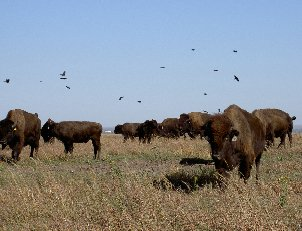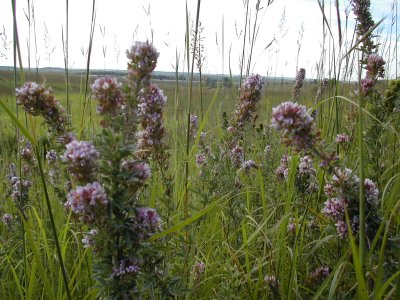The effects of bison grazing on plant diversity in a tallgrass prairie (Konza Prairie LTER)
Overview
This section is written for faculty who can modify the Overview as appropriate for their students. “Student Instructions” also include introductory material.
The Konza Prairie Biological Station (KPBS) encompasses 3,487 hectares of native tallgrass prairie. Established as a preserve in 1971, it is currently owned by The Nature Conservancy. The Kansas State University Division of Biology manages KPBS as a field research station.
KPBS lies within the larger Flint Hills region of Kansas and northern Oklahoma, which are characterized by steeply sloping hills (Figure 1). Because the shallow soils of the region are not conducive to farming, KPBS and much of the surrounding Flint Hills have never been ploughed. The Flint Hills constitute the largest contiguous area of unplowed tallgrass prairie remaining in North America. The Flint Hills are at the southern and western edge of the historical extent of tallgrass prairie, which extended to southern Minnesota in the north and Indiana in the east.

Figure 1. Map of the conterminous United States showing the location of Konza Prairie within the Flint Hills region of Kansas.
The tallgrass prairie at KPBS is dominated by the perennial, warm-season grasses Andropogon gerardii (big bluestem), Schizachyrium scoparium (little bluestem), and Sorghastrum nutans (Indiangrass). Other important, though less abundant groups include warm-season and cool-season grasses, composites, legumes, and other forbs (Photo 1). A few woody species such as Ceanothus cuneatus (buckbrush) and Rhus glabra (smooth sumac) are locally common. The grasses can reach heights of two and a half meters in the wettest years, which is why this vegetation is known as tallgrass prairie.
Photo 1. Lespedeza stuevei growing amongst a mixture of big bluestem and Indian grass. Photo by T. M. Woods
KPBS was one of the original eight sites of the NSF-funded Long-Term Ecological Research (LTER) program (www.lternet.edu). A fully replicated, watershed-level experimental design has been in place since 1977 to test the effects of a key driver of tallgrass prairie ecosystems: fire (Knapp and Seastedt 1998). In 1987, bison were re-introduced to KPBS to study the effects of another important ecosystem driver in tallgrass prairie: ungulate grazing (Photo 2). Lastly, meteorological instruments have collected weather data since the 1970’s to examine the importance of the third important driver of tallgrass prairie ecosystems: a variable continental climate.

Photo 2. Bison were re-introduced to Konza in 1987 and graze the tallgrass prairie year round. Each animal is tagged with an identification number, which allows researchers to track the growth of individual animals. In addition to grazing, bison create wallows (seen in the center of the photo). Both the grazing and wallowing activities of bison increase the heterogeneity of the prairie. Photo by H. J. Dalgleish
Over the years, the Konza LTER program has built a long-term database derived from the watershed-level fire and grazing experiments. One of the long-term datasets collected at KPBS includes the plant species composition dataset. Twice a year, a researcher samples permanent transects in several watersheds to estimate the relative abundances of all the plant species that are present. Along each transect, there are five circular plots, each 10 m2 in area (Figure 2). Within each plot, the researcher identifies each species and estimates how much of the plot is covered by that species (a measure of abundance, which we will explore more later in the exercise).

Figure 2. Konza Prairie is divided into watershed units, and each watershed has a different treatment combination of fire frequency and grazing. Long-term research watersheds, such as N1B detailed here, have four permanent transects in the uplands and four permanent transects in the lowlands. Twice a year, a researcher samples permanent transects to estimate the relative abundances of all the plant species that are present.
We will use plant community data from two of these watersheds in this exercise. One has been grazed by bison since 1992 while the other has been protected from grazing by both bison and cattle since 1981, and both are burned annually (Vinton et al. 1993, Hartnett et al. 1996, Collins et al. 1998, Collins and Steinauer 1998, Knapp et al. 1999). We will use data from 20 plots (four transects) located in the lowland areas of each watershed.
References
- Collins, S. L., A. K. Knapp, J. M. Briggs, J. M. Blair, and E. M. Steinauer. 1998. Modulation of diversity by grazing and mowing in native tallgrass prairie. Science 280:745-747.
- Collins, S. L., and E. M. Steinauer. 1998. Disturbance, diversity, and species interactions in tallgrass prairie. Pages 140-156 in A. K. Knapp, J. M. Briggs, D. C. Hartnett, and S. L. Collins, editors. Grassland dynamics: long-term ecological research intallgrass prairie. Oxford University Press, Oxford, UK.
- Hartnett, D. C., K. R. Hickman, and L. E. Fischer Walter. 1996. Effects of bison grazing, fire, and topography on floristic diversity in tallgrass prairie. Journal of Range Management 49:413-420.
- Knapp, A. K., J. M. Blair, J. M. Briggs, S. L. Collins, D. C. Hartnett, L. C. Johnson, and E. G. Towne. 1999. The keystone role of bison in the North American tallgrass prairie. BioScience 49:39-50.
- Knapp, A. K., and T. R. Seastedt. 1998. Grasslands, Konza Prairie, and long-term ecological research. in A. K. Knapp, J. M. Briggs, D. C. Hartnett, and S. L. Collins, editors. Grassland dynamics: long-term ecological research in tallgrass prairie. Oxford University Press, Oxford, UK.
- Vinton, M. A., D. C. Hartnett, E. J. Finck, and J. M. Briggs. 1993. Interactive effects of fire, bison (Bison bison) grazing and plant community composition in tallgrass prairie. American Midland Naturalist 129:10-18.
